
Columbus (ISS module)
Encyclopedia
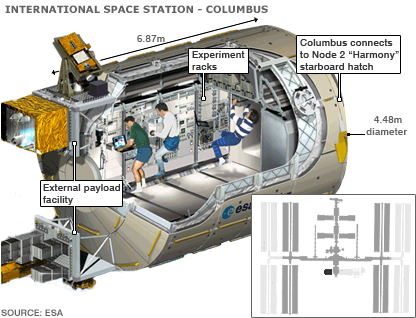
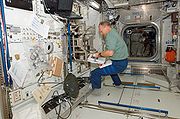
International Space Station
The International Space Station is a habitable, artificial satellite in low Earth orbit. The ISS follows the Salyut, Almaz, Cosmos, Skylab, and Mir space stations, as the 11th space station launched, not including the Genesis I and II prototypes...
(ISS) and is the largest single contribution to the ISS made by the European Space Agency
European Space Agency
The European Space Agency , established in 1975, is an intergovernmental organisation dedicated to the exploration of space, currently with 18 member states...
(ESA).
Like the Harmony and Tranquility modules, the Columbus laboratory was constructed in Turin
Turin
Turin is a city and major business and cultural centre in northern Italy, capital of the Piedmont region, located mainly on the left bank of the Po River and surrounded by the Alpine arch. The population of the city proper is 909,193 while the population of the urban area is estimated by Eurostat...
, Italy
Italy
Italy , officially the Italian Republic languages]] under the European Charter for Regional or Minority Languages. In each of these, Italy's official name is as follows:;;;;;;;;), is a unitary parliamentary republic in South-Central Europe. To the north it borders France, Switzerland, Austria and...
by Rome
Rome
Rome is the capital of Italy and the country's largest and most populated city and comune, with over 2.7 million residents in . The city is located in the central-western portion of the Italian Peninsula, on the Tiber River within the Lazio region of Italy.Rome's history spans two and a half...
based Alcatel Alenia Space with respect to structures and thermal control. The functional architecture (including software) of the lab was designed by EADS
EADS
The European Aeronautic Defence and Space Company N.V. is a global pan-European aerospace and defence corporation and a leading defence and military contractor worldwide...
in Germany
Germany
Germany , officially the Federal Republic of Germany , is a federal parliamentary republic in Europe. The country consists of 16 states while the capital and largest city is Berlin. Germany covers an area of 357,021 km2 and has a largely temperate seasonal climate...
where it was also integrated before being flown to the Kennedy Space Center
Kennedy Space Center
The John F. Kennedy Space Center is the NASA installation that has been the launch site for every United States human space flight since 1968. Although such flights are currently on hiatus, KSC continues to manage and operate unmanned rocket launch facilities for America's civilian space program...
(KSC) in Florida
Florida
Florida is a state in the southeastern United States, located on the nation's Atlantic and Gulf coasts. It is bordered to the west by the Gulf of Mexico, to the north by Alabama and Georgia and to the east by the Atlantic Ocean. With a population of 18,801,310 as measured by the 2010 census, it...
in an Airbus Beluga
Airbus Beluga
-External links:*...
. It was launched aboard Space Shuttle
Space Shuttle
The Space Shuttle was a manned orbital rocket and spacecraft system operated by NASA on 135 missions from 1981 to 2011. The system combined rocket launch, orbital spacecraft, and re-entry spaceplane with modular add-ons...
Atlantis
Space Shuttle Atlantis
The Space Shuttle Atlantis is a retired Space Shuttle orbiter in the Space Shuttle fleet belonging to the National Aeronautics and Space Administration , the spaceflight and space exploration agency of the United States...
on February 7, 2008 on flight STS-122
STS-122
STS-122 was a NASA Space Shuttle mission to the International Space Station , flown by the Space Shuttle Atlantis. STS-122 marked the 24th shuttle mission to the ISS, and the 121st space shuttle flight since STS-1....
. It is designed for ten years of operation. The module is controlled by the Columbus Control Centre, located at the German Space Operations Centre, part of the German Aerospace Center
German Aerospace Center
The German Aerospace Center is the national centre for aerospace, energy and transportation research of the Federal Republic of Germany. It has multiple locations throughout Germany. Its headquarters are located in Cologne. It is engaged in a wide range of research and development projects in...
in Oberpfaffenhofen
Oberpfaffenhofen
Oberpfaffenhofen is a village which is part of the municipality of Weßling in the district of Starnberg, Bavaria, Germany. It is 20 kilometers from the city center of Munich....
near Munich
Munich
Munich The city's motto is "" . Before 2006, it was "Weltstadt mit Herz" . Its native name, , is derived from the Old High German Munichen, meaning "by the monks' place". The city's name derives from the monks of the Benedictine order who founded the city; hence the monk depicted on the city's coat...
, Germany.
The European Space Agency has spent €
Euro
The euro is the official currency of the eurozone: 17 of the 27 member states of the European Union. It is also the currency used by the Institutions of the European Union. The eurozone consists of Austria, Belgium, Cyprus, Estonia, Finland, France, Germany, Greece, Ireland, Italy, Luxembourg,...
1.4 billion (about US$
United States dollar
The United States dollar , also referred to as the American dollar, is the official currency of the United States of America. It is divided into 100 smaller units called cents or pennies....
2 billion) on building Columbus, including the experiments that will fly in it and the ground control infrastructure necessary to operate them.
Description
The laboratory is a cylindrical module with two end cones. It is 4477 mm (15 ft) in external diameter and 6871 mm (23 ft) in overall length, excluding the projecting external experiment racks. Its shape is very similar to that of the Multi-Purpose Logistics ModuleMulti-Purpose Logistics Module
A Multi-Purpose Logistics Module is a large pressurized container used on Space Shuttle missions to transfer cargo to and from the International Space Station . An MPLM was carried in the cargo bay of a Shuttle and berthed to the Unity or Harmony modules on the ISS. From there, supplies were...
s (MPLMs),
since both were designed to fit in the cargo bay of a Space Shuttle orbiter. The starboard end cone contains most of the laboratory's on-board computers. The port end cone contains the Common Berthing Mechanism
Common Berthing Mechanism
The common berthing mechanism is a berthing mechanism used to connect all non-Russian pressurized modules of the International Space Station....
.
Construction
ESA chose EADS Astrium Space Transportation as prime contractor for Columbus. The Columbus flight structure, the micro-meteorite protection system, the active and passive thermal control, the environmental control, the harness and all the related ground support equipment were designed and qualified by Alcatel Alenia Space in TurinTurin
Turin is a city and major business and cultural centre in northern Italy, capital of the Piedmont region, located mainly on the left bank of the Po River and surrounded by the Alpine arch. The population of the city proper is 909,193 while the population of the urban area is estimated by Eurostat...
, Italy
Italy
Italy , officially the Italian Republic languages]] under the European Charter for Regional or Minority Languages. In each of these, Italy's official name is as follows:;;;;;;;;), is a unitary parliamentary republic in South-Central Europe. To the north it borders France, Switzerland, Austria and...
as defined by the PICA - Principle (for definition see History below); the related hardware was pre-integrated and sent as PICA in September 2001 to Bremen. The lab was then fully integrated and qualified on system level at the EADS Astrium Space Transportation facilities in Bremen, Germany.
Launch, berthing and outfitting


Space Station Processing Facility
The Space Station Processing Facility is a three-story, 42,500 m2 buildinglocated in the Kennedy Space Center industrial area, just east of the Operations and Checkout Building....
, and installed into the payload bay of the Atlantis orbiter for launch on ISS assembly flight 1E.
During cryo-filling of the space shuttle External Tank
Space Shuttle external tank
A Space Shuttle External Tank is the component of the Space Shuttle launch vehicle that contains the liquid hydrogen fuel and liquid oxygen oxidizer. During lift-off and ascent it supplies the fuel and oxidizer under pressure to the three Space Shuttle Main Engines in the orbiter...
(ET) with liquid hydrogen
Liquid hydrogen
Liquid hydrogen is the liquid state of the element hydrogen. Hydrogen is found naturally in the molecular H2 form.To exist as a liquid, H2 must be pressurized above and cooled below hydrogen's Critical point. However, for hydrogen to be in a full liquid state without boiling off, it needs to be...
and liquid oxygen
Liquid oxygen
Liquid oxygen — abbreviated LOx, LOX or Lox in the aerospace, submarine and gas industries — is one of the physical forms of elemental oxygen.-Physical properties:...
prior to the first launch attempt on December 6, 2007, two of four LH2 ECO sensors failed a test. Mission rules called for at least three of the four sensors to be in working order for a launch attempt to proceed. As a result of the failure, the Launch Director Doug Lyons postponed the launch, initially for 24 hours. This was later revised into a 72 hour delay, resulting in a next launch attempt set for Sunday December 9, 2007. This launch attempt was scrubbed when one of the ECO sensors again failed during fuelling.
The ECO sensors external connector was changed on the space shuttle external tank, causing a two month delay in the launch. Columbus was finally launched successfully on the third attempt at 2:45pm EST, February 7, 2008.
Once at the station, Canadarm2 removed Columbus from the docked shuttle's cargo bay
and attached it to the starboard hatch of Harmony (also known as Node 2),
with the cylinder pointing outwards on February 11, 2008.
Research activities and payloads
Activities in the lab are controlled on the ground by the Columbus Control Centre (at DLRGerman Aerospace Center
The German Aerospace Center is the national centre for aerospace, energy and transportation research of the Federal Republic of Germany. It has multiple locations throughout Germany. Its headquarters are located in Cologne. It is engaged in a wide range of research and development projects in...
Oberpfaffenhofen
Oberpfaffenhofen
Oberpfaffenhofen is a village which is part of the municipality of Weßling in the district of Starnberg, Bavaria, Germany. It is 20 kilometers from the city center of Munich....
in Germany) and by the associated User Support Operations Centres throughout Europe.
The laboratory can accommodate ten active International Standard Payload Racks
ISPR
The International Standard Payload Rack has been adopted by the International Space Station program to support efficient integration and interchangeability of payload hardware – and to maximize joint research among investigators. The 37 ISPR slots for science payloads on ISS provide a...
(ISPRs) for science payloads.
Agreements with NASA allocate to ESA 51% usage of the Columbus Laboratory.
ESA is thus allocated five active rack locations, with the other five being allocated to NASA.
Four active rack locations are on the forward side of the deck, four on the aft side, and two are in overhead locations.
Three of the deck racks are filled with life support and cooling systems.
The remaining deck rack and the two remaining overhead racks are storage racks.
In addition, four un-pressurized payload platforms can be attached outside the starboard cone, on the Columbus External Payload Facility (CEPF). Each external payload is mounted on an adaptor able to accommodate small instruments and experiments totalling up to 230 kilograms (507 lb).
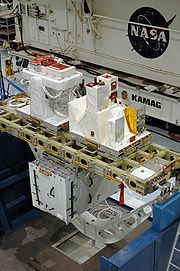
- Fluid Science LaboratoryFluid Science LaboratoryThe Fluid Science Laboratory is a European science payload designed for use in Columbus built by Alenia Aeronautica Spazio and OHB-System. It is a multi-user facility for conducting fluid physics research in microgravity conditions...
(FSL) - European Physiology ModulesEuropean Physiology ModulesThe European Physiology Module is an International Standard Payload Rack for the Columbus Laboratory on board the International Space Station. The EPM rack was built by OHB-System in Bremen....
(EPM) - BiolabBiolabBiolab is a single-rack multi-user science payload designed for use in the Columbus laboratory of the International Space Station.Biolab does support biological research on small plants, small invertebrates, microorganisms, animal cells, and tissue cultures.It includes an incubator equipped with...
- European Drawer Rack (EDR)
- European Storage Rack
The first external payloads were mounted on Columbus by crew members of the mission STS-122 mission. The three payloads mounted are:
- European Technology Exposure FacilityEuropean Technology Exposure FacilityThe European Technology Exposure Facility is a payload mounted on the exterior of the European Columbus laboratory, one of the modules of the International Space Station...
(EuTEF) platform, which accommodates nine instruments: TRIBOLAB, PLEGPAY, MEDET, EUFIDE, DEBIE-2, FIPEX, EUTEMP, EXPOSE, DOSTEL, and the Earth Viewing Camera. - Solar Monitoring ObservatorySolar Monitoring ObservatoryThe Solar Monitoring Observatory is an ESA science observatory that is part of the Columbus Laboratory, which is a component of the International Space Station. The Columbus module was launched February 2008 aboard STS-122. SOLAR was externally mounted to the Columbus Laboratory, together with...
(SOLAR) - MISSE-6MisséMissé is a commune in the Deux-Sèvres department in western France.It is situated on the River Thouet some 5 km upstream from the town of Thouars, and is the site of a spectacular loop in the river.-References:*...
(NASA payload)
Planned additional external payload:
- Atomic Clock Ensemble in SpaceAtomic Clock Ensemble in SpaceAtomic Clock Ensemble in Space is a project led by the European Space Agency which will place an ultra-stable atomic clock on the International Space Station...
(ACES) - EXPORTEXPORTEXPORT is an exobiology project led by the European Space Agency, that is planned to be deployed on the International Space Station to study the photo-processing of organic molecules and the survival of micro-organisms in space, as well as the effect of solar UV on unshielded organic molecules and...
- Atmosphere-Space Interaction MonitorAtmosphere-Space Interaction MonitorAtmosphere-Space Interaction Monitor is a project led by the European Space Agency. It will place cameras and x-ray- and γ-detectors on the International Space Station, where it will observe the upper atmosphere, looking for sprites, jets and elves in connection with thunderstorms...
(ASIM)
See also:
- European Transportation Carrier (ISS Facility) (ETC)
- Columbus – External Payload FacilityColumbus – External Payload FacilityThe Columbus External Payload Facility consists of two identical L-shaped consoles attached to the starboard cone of Columbus in the zenith and nadir positions, each supporting two platforms for external payloads or payload facilities...
(Columbus-EPF)
History

European Space Agency
The European Space Agency , established in 1975, is an intergovernmental organisation dedicated to the exploration of space, currently with 18 member states...
program to develop an autonomous manned space station
Space station
A space station is a spacecraft capable of supporting a crew which is designed to remain in space for an extended period of time, and to which other spacecraft can dock. A space station is distinguished from other spacecraft used for human spaceflight by its lack of major propulsion or landing...
that could be used for a variety of microgravity experiments. The program ran from 1986 to 1991 and included three components: a Man-Tended Free Flyer (MTFF) element serviced by the Hermes
Hermes (shuttle)
Hermes was a proposed spaceplane designed by the French Centre National d'Études Spatiales in 1975, and later by the European Space Agency. It was superficially similar to the US X-20. France proposed in January 1985 to go through with Hermes development under the auspices of the ESA. Hermes was...
shuttle, an Attached Pressurized Module (APM), and a Polar Platform (PPF). After several budget cuts and cancellation of Hermes
Hermes (shuttle)
Hermes was a proposed spaceplane designed by the French Centre National d'Études Spatiales in 1975, and later by the European Space Agency. It was superficially similar to the US X-20. France proposed in January 1985 to go through with Hermes development under the auspices of the ESA. Hermes was...
, all that remained in the Columbus program was the APM, finally renamed to Columbus.
When only the APM was left in the program there were not enough tasks for the two main contributors Germany and Italy represented by MBB
Messerschmitt-Bölkow-Blohm
Messerschmitt-Bölkow-Blohm was a German aerospace company formed as the result of several mergers in the late 1960s. Among its best-known products was the MBB Bo 105 light twin helicopter...
-ERNO
Entwicklungsring Nord
The Entwicklungsring Nord - abbreviated ERNO - was a 1961 joint venture of Bremen-based Weserflug and Focke-Wulf with Hamburger Flugzeugbau to develop parts for rockets and get involved in space activities....
and Alenia
Thales Alenia Space
Thales Alenia Space is an aerospace company born after the Thales Group bought the participation of Alcatel in the two joint-ventures between Alcatel and Finmeccanica, Alcatel Alenia Space and Telespazio.-History:...
respectively. As compromise the PICA (Pre Integrated Columbus APM) - Principle was invented meaning a split responsibility where Alenia as a co-prime is responsible for the overall Columbus configuration, the mechanical and thermal/life support systems, HFE and harness design/manufacturing whereas EADS Astrium Space Transportation is responsible for the overall Columbus design and all Avionics systems including electrical harness design and software. Splitting off systems engineering responsibility and harness design under separate fixed-price contracts was found not to be advantageous with respect to efficiency and fast decision making as financial reasonings were pre-dominant in the last phase of development and verification.
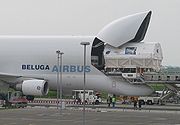
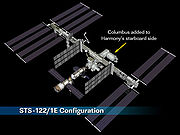
NASA
The National Aeronautics and Space Administration is the agency of the United States government that is responsible for the nation's civilian space program and for aeronautics and aerospace research...
by Thales Alenia Space. In 2000 the pre-integrated module (structure including harness and tubing) was delivered to Bremen in Germany by the Co-prime contractor Alenia. The final integration and system testing was performed by the overall prime contractor EADS Astrium Space Transportation, after that the initial Payload was integrated and the overall complement checked-out.
On May 27, 2006 Columbus was flown from Bremen
Bremen
The City Municipality of Bremen is a Hanseatic city in northwestern Germany. A commercial and industrial city with a major port on the river Weser, Bremen is part of the Bremen-Oldenburg metropolitan area . Bremen is the second most populous city in North Germany and tenth in Germany.Bremen is...
, Germany to Kennedy Space Center
Kennedy Space Center
The John F. Kennedy Space Center is the NASA installation that has been the launch site for every United States human space flight since 1968. Although such flights are currently on hiatus, KSC continues to manage and operate unmanned rocket launch facilities for America's civilian space program...
on board an Airbus Beluga.
The final schedule was much longer than originally planned due to development problems (several caused by the complex responsibility splitting between the Co-prime and the Overall prime contractor) and design changes introduced by ESA but being affordable due to the Shuttle problems delaying the Columbus launch for several years. The main design change was the addition of the External Payload Facility (EPF), which was driven by the different European Payload organizations being more interested in outer space than internal experiments. Also the addition of a terminal for direct communications to/from ground, which could have been used also as back-up for the ISS system, was studied but not implemented for cost reasons.
Specifications
- Length: 7 m (23 ft)
- Diameter: 4.5 m (15 ft)
- Total mass: 10300 kg (22,708 lb)
- Total payload mass 2500 kg (5,512 lb)
- Total on-orbit mass 12800 kg (28,219 lb)

